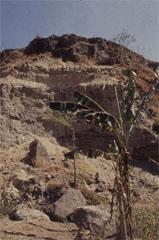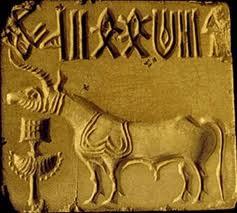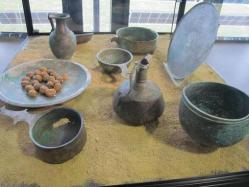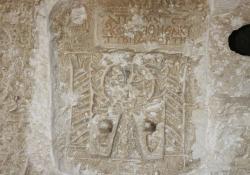INSTITUT SUPERIEUR D'ANTHROPOLOGIE
INSTITUTE OF ANTHROPOLOGY
ONLINE COURSES / COURS A DISTANCE
FALL TERM : OCTOBER 2013
REGISTER NOW
TURQUIE –  Bodrum - A historic handwritten Quran was discovered in an old mosque in Bodrum. Yüksel Kılınçarslan, the imam of Tepecik Mosque, which has been serving the local community since 1737 on Neyzen Tevfik Avenue, noticed the 1,200 year-old Quran in the imam’s room and informed officials about it. Kılınçarslan said that he had found the Quran in a piece of cloth. “We did not give it any importance thinking that it was an ordinary Quran. But I realized that it is handwritten and the figures on it show that it dates back to 1,200 years ago. I went to Ankara to talk to officials and they asked me to give it to the relevant institute,” he said.
Bodrum - A historic handwritten Quran was discovered in an old mosque in Bodrum. Yüksel Kılınçarslan, the imam of Tepecik Mosque, which has been serving the local community since 1737 on Neyzen Tevfik Avenue, noticed the 1,200 year-old Quran in the imam’s room and informed officials about it. Kılınçarslan said that he had found the Quran in a piece of cloth. “We did not give it any importance thinking that it was an ordinary Quran. But I realized that it is handwritten and the figures on it show that it dates back to 1,200 years ago. I went to Ankara to talk to officials and they asked me to give it to the relevant institute,” he said.
http://www.hurriyetdailynews.com/historic-quran-found-in-mosque-in-turkeys-mugla.aspx?pageID=238&nID=54475&NewsCatID=375
INDONESIE –  Sangiran - Archaeologists in Central Java have discovered fossil evidence that prehistoric humans may have hunted a forerunner to the elephant that was twice the size of today’s pachyderms.The location of the excavation is in the neighborhood of Sragen district’s Sangiran Dome, an area declared by Unesco in 1996 as a World Heritage Site for its abundance of prehistoric fossils. Around half of the human ancestor fossils found in the world have been found in this area. “This square excavation site offers stories from the prehistoric age that we want to reveal,” said Professor Truman Simanjuntak, a senior archaeologist and the leader of the National Archaeology Center excavation team.“We have also found animal fossils and hunter artifacts nearby and have suggested that the site be developed as a field museum, not just a research area.” Truman said that his team’s discovery of the latest remains — belonging to a stegodon (Stegodon trigonocephalus), a distant relat i ve of the modern elephant, and a prehistoric buffalo (Babulus paleokarabau) — were very important because they would help to answer several questions about prehistoric life. The stegodon and buffalo were believed to have lived around 800,000 years ago. During the Pleistocene area, when Java was still connected to the Asia mainland, some animal populations migrated to the Sangiran area. They were trapped in the region after the sea level rose and separated the island from Asia. Finding animal and hunter artifacts at a single location raised the possibility that forerunners to modern-day humans may have hunted and eaten these animals, Truman said. But he added that this hypothesis required more research. The stegodon fossil, found five meters below the surface, includes a head, teeth, femur and other bone fragments. The buffalo fossil consisted of only a head with a set of large horns. The archaeologists also found several ball-shaped rocks near the stegodon fossil, which they have identified as weapons used for hunting. “The rock ball was formed by cutting, not by the natural process of erosion, because you can see from the texture that the abrasion isn’t uniform,” said Ruly Fauzi, an archeologist with the team. “It was made using a very rudimentary cutting technique.”
Sangiran - Archaeologists in Central Java have discovered fossil evidence that prehistoric humans may have hunted a forerunner to the elephant that was twice the size of today’s pachyderms.The location of the excavation is in the neighborhood of Sragen district’s Sangiran Dome, an area declared by Unesco in 1996 as a World Heritage Site for its abundance of prehistoric fossils. Around half of the human ancestor fossils found in the world have been found in this area. “This square excavation site offers stories from the prehistoric age that we want to reveal,” said Professor Truman Simanjuntak, a senior archaeologist and the leader of the National Archaeology Center excavation team.“We have also found animal fossils and hunter artifacts nearby and have suggested that the site be developed as a field museum, not just a research area.” Truman said that his team’s discovery of the latest remains — belonging to a stegodon (Stegodon trigonocephalus), a distant relat i ve of the modern elephant, and a prehistoric buffalo (Babulus paleokarabau) — were very important because they would help to answer several questions about prehistoric life. The stegodon and buffalo were believed to have lived around 800,000 years ago. During the Pleistocene area, when Java was still connected to the Asia mainland, some animal populations migrated to the Sangiran area. They were trapped in the region after the sea level rose and separated the island from Asia. Finding animal and hunter artifacts at a single location raised the possibility that forerunners to modern-day humans may have hunted and eaten these animals, Truman said. But he added that this hypothesis required more research. The stegodon fossil, found five meters below the surface, includes a head, teeth, femur and other bone fragments. The buffalo fossil consisted of only a head with a set of large horns. The archaeologists also found several ball-shaped rocks near the stegodon fossil, which they have identified as weapons used for hunting. “The rock ball was formed by cutting, not by the natural process of erosion, because you can see from the texture that the abrasion isn’t uniform,” said Ruly Fauzi, an archeologist with the team. “It was made using a very rudimentary cutting technique.”
http://www.thejakartaglobe.com/news/fossils-shed-light-on-sangiran-hunters/
INDE -  Padmanabhapuram – The Kerala Archaeology Department is seeking expert advice to determine the provenance of ‘Indus Valley Seals’ found at the Padmanabhapuram Palace in southern Tamil Nadu. The Department has sought the help of noted epigraphist and expert on Indus Valley script, Iravatham Mahadevan, to see whether the seals are genuine Indus Valley artefacts or replicas. “He has agreed to send an official down from Chennai to examine the seals. What we have learned so far is that the seals were sent to Travancore by the British archaeologist Mortimer Wheeler,” Archaeology Department director G Premkumar said. (A former director general of the Archaeology Survey of India during British rule, Wheeler had conducted explorations in Harappa, Mohenjodaro and other Indus Valley sites). It is presumed that the seals were sent to Travancore for studying their Dravidian origins. For decades since Independence, the objects lay forgotten in a box at the palace. In June this year, the Archaeology Department had stumbled upon the seals - numbering some 60 - during the renovation of the Padmanabhapuram Palace. The stone-and-wood structure which once belonged to the Travancore royal family, though in Kanyakumari district of Tamil Nadu, is held by the Kerala Archaeology Dept.
Padmanabhapuram – The Kerala Archaeology Department is seeking expert advice to determine the provenance of ‘Indus Valley Seals’ found at the Padmanabhapuram Palace in southern Tamil Nadu. The Department has sought the help of noted epigraphist and expert on Indus Valley script, Iravatham Mahadevan, to see whether the seals are genuine Indus Valley artefacts or replicas. “He has agreed to send an official down from Chennai to examine the seals. What we have learned so far is that the seals were sent to Travancore by the British archaeologist Mortimer Wheeler,” Archaeology Department director G Premkumar said. (A former director general of the Archaeology Survey of India during British rule, Wheeler had conducted explorations in Harappa, Mohenjodaro and other Indus Valley sites). It is presumed that the seals were sent to Travancore for studying their Dravidian origins. For decades since Independence, the objects lay forgotten in a box at the palace. In June this year, the Archaeology Department had stumbled upon the seals - numbering some 60 - during the renovation of the Padmanabhapuram Palace. The stone-and-wood structure which once belonged to the Travancore royal family, though in Kanyakumari district of Tamil Nadu, is held by the Kerala Archaeology Dept.
http://newindianexpress.com/cities/thiruvananthapuram/Experts-opinion-on-authenticity-of-Indus-Valley-Seals-sought/2013/09/16/article1787029.ece
INDE –  Panagal - The historical Chaya Someshwara Swamy temple located at Panagal is all set to get a new look very soon as the Department of Archaeology and Museums is preparing to provide chemical treatment to the temple walls to remove fungus. Assistant Chemist K. Rambabu said the Archaeology and Museums Department does not allow painting of walls build of rock as it mars the natural sheen of the temple. As Chaya Someshwara Swamy temple was built by Kundur Cholas who ruled Nalgonda, Khammam and Mahabubnagar districts between 1040 AD and 1290 AD, Mr. Rambabu said the temple walls were painted many a times by various successive kings. Due to lack of regular maintenance over the years, the walls have gathered fungus. He informed that they will use natural detergents and Ammonia to remove fungus, Oxalic Acid to remove enamel, Formalin and other chemicals to remove white cement. They will also take up measures to preserve the temple walls.
Panagal - The historical Chaya Someshwara Swamy temple located at Panagal is all set to get a new look very soon as the Department of Archaeology and Museums is preparing to provide chemical treatment to the temple walls to remove fungus. Assistant Chemist K. Rambabu said the Archaeology and Museums Department does not allow painting of walls build of rock as it mars the natural sheen of the temple. As Chaya Someshwara Swamy temple was built by Kundur Cholas who ruled Nalgonda, Khammam and Mahabubnagar districts between 1040 AD and 1290 AD, Mr. Rambabu said the temple walls were painted many a times by various successive kings. Due to lack of regular maintenance over the years, the walls have gathered fungus. He informed that they will use natural detergents and Ammonia to remove fungus, Oxalic Acid to remove enamel, Formalin and other chemicals to remove white cement. They will also take up measures to preserve the temple walls.
http://www.thehindu.com/news/national/andhra-pradesh/someshwara-temple-to-shine-soon/article5132035.ece?homepage=true
FRANCE – Poitiers - La rue Bourcani est l'endroit de Poitiers où l'on voit le mieux les vestiges de l'amphithéâtre romain et chacun a bien conscience qu'il faut les protéger. On vient d'y acquérir le numéro 4 bis qui comporte trois travées de la partie nord-ouest de l'édifice, se félicite pour la Ville l'adjoint Jean-Marie Compte. « Cela permet dans un premier temps d'engager une étude préalable qui sera menée dès les prochains jours par l'archéologue municipal Christophe Belliard, poursuit l'élu, les résultats vont permettre par exemple de connaître le mode de circulation interne des spectateurs. » La mission archéologique confiée par la Ville à Christophe Belliard au niveau de la rue Bourcani va porter dans un premier temps sur « l'étude du bâti » : un travail descriptif et analytique des caractéristiques de la construction et de la réappropriation du monument dans le tissu urbain. « Un autre enjeu résidera dans une approche stratigraphique à l'occasion d'une vraisemblable fouille programmée à l'intérieur du 4 bis qui devrait permettre de retrouver les bases du monument antique et le premier niveau de circulation. » Étude et fouilles vont ouvrir une compréhension tout-à-fait inédite du monument grâce à une lecture de sa base jusqu'à son élévation. L'archéologue s'en réjouit à l'avance : « tout cela va permettre d'apporter des clés en vue du projet de mise en valeur du site ». Et comme ce qui fut l'une des plus grandes arènes de la Gaule romaine s'étendait bien au-delà de la rue Bourcani, la Ville, bien décidée à donner un nouvel éclairage sur ce patrimoine, va également confier un travail d'inventaire des vestiges sur l'ensemble du quartier à un opérateur archéologique extérieur.
http://www.lanouvellerepublique.fr/Toute-zone/Loisirs/Patrimoine-tourisme/n/Contenus/Articles/2013/09/14/Les-Arenes-etudiees-avant-leur-mise-en-valeur-1611924
FRANCE –  Argentomagus - Un service à vin exceptionnel provenant de la dernière campagne de fouilles d’Argentomagus est présenté en avant-première au musée. Cet ensemble utilisé pendant près de quatre siècles et dont la fonction précise reste à déterminer a laissé apparaître un bâtiment quadrangulaire de cinq mètres de large près duquel est apparu un dépôt. C'est là, dans ce qui semble être pour l'instant une structure de chauffe et peut être un four, que le service à vin a été mis à jour. Il se compose de quinze objets pour la plupart en alliage cuivreux (bronze), dont trois vases complets qui ont permis de le dater au IIIe siècle. Si quelques cas similaires sont connus en France, une telle trouvaille reste assez rare et est inédite à Argentomagus. Ces pièces, dont les archéologues vantent « la facture et l'état de conservation remarquables », ont été découvertes dans un grand chaudron d'environ 80 cm de diamètre. Le récipient contenait également les fragments de deux autres chaudrons plus petits, une anse en fer, deux casseroles, deux cruches, dont l'une possède une anse décorée d'Hercule se reposant et Télèphe accompagné d'une chèvre, mais aussi une coupe, un bassin, une passoire avec un bec verseur orné d'une tête porcine et de deux plats argentés. L'un d'eux comporte un petit médaillon central, où figure un griffon.
Argentomagus - Un service à vin exceptionnel provenant de la dernière campagne de fouilles d’Argentomagus est présenté en avant-première au musée. Cet ensemble utilisé pendant près de quatre siècles et dont la fonction précise reste à déterminer a laissé apparaître un bâtiment quadrangulaire de cinq mètres de large près duquel est apparu un dépôt. C'est là, dans ce qui semble être pour l'instant une structure de chauffe et peut être un four, que le service à vin a été mis à jour. Il se compose de quinze objets pour la plupart en alliage cuivreux (bronze), dont trois vases complets qui ont permis de le dater au IIIe siècle. Si quelques cas similaires sont connus en France, une telle trouvaille reste assez rare et est inédite à Argentomagus. Ces pièces, dont les archéologues vantent « la facture et l'état de conservation remarquables », ont été découvertes dans un grand chaudron d'environ 80 cm de diamètre. Le récipient contenait également les fragments de deux autres chaudrons plus petits, une anse en fer, deux casseroles, deux cruches, dont l'une possède une anse décorée d'Hercule se reposant et Télèphe accompagné d'une chèvre, mais aussi une coupe, un bassin, une passoire avec un bec verseur orné d'une tête porcine et de deux plats argentés. L'un d'eux comporte un petit médaillon central, où figure un griffon.
http://www.lanouvellerepublique.fr/Toute-zone/Loisirs/Patrimoine-tourisme/n/Contenus/Articles/2013/09/15/Les-archeologues-trinquent-a-leur-derniere-decouverte-1613232
CANADA –  Trois Rivières - Pour la première fois en huit ans, les étudiants du programme Histoire et civilisation du Collège Laflèche procèderont à des fouilles archéologiques à l'arrière du cimetière des Ursulines, du 16 au 27 septembre. Ce nouveau site s'annonce des plus prometteurs, puisque les sondages exploratoires ont permis de confirmer la présence de vestiges d'une buanderie qui a probablement été construite en 1721. Certains documents portent également à croire que ce bâtiment aurait aussi servi de boulangerie, de résidence et même d'école. «Ce qui est extraordinaire ici, c'est que le site est occupé depuis 300 ans par la même communauté qui est toujours restée au même endroit. C'est un espace qui a relativement été protégé de l'étalement urbain et qui a moins subi de transformations. Ça confère au site un potentiel intéressant. On pourra sans doute trouver des vestiges», mentionne Louis Gilbert, archéologue au Collège Laflèche. M. Gilbert espère également pouvoir relever des vestiges d'une loge des «insensées», un bâtiment qui a été peu étudié d'un point de vue archéologique. Les loges des «insensées» étaient utilisées dans les hôpitaux, gérés par des congrégations religieuses à l'époque, pour enfermer des personnes «insensées», c'est-à-dire les pauvres mendiantes, valides et invalides.
Trois Rivières - Pour la première fois en huit ans, les étudiants du programme Histoire et civilisation du Collège Laflèche procèderont à des fouilles archéologiques à l'arrière du cimetière des Ursulines, du 16 au 27 septembre. Ce nouveau site s'annonce des plus prometteurs, puisque les sondages exploratoires ont permis de confirmer la présence de vestiges d'une buanderie qui a probablement été construite en 1721. Certains documents portent également à croire que ce bâtiment aurait aussi servi de boulangerie, de résidence et même d'école. «Ce qui est extraordinaire ici, c'est que le site est occupé depuis 300 ans par la même communauté qui est toujours restée au même endroit. C'est un espace qui a relativement été protégé de l'étalement urbain et qui a moins subi de transformations. Ça confère au site un potentiel intéressant. On pourra sans doute trouver des vestiges», mentionne Louis Gilbert, archéologue au Collège Laflèche. M. Gilbert espère également pouvoir relever des vestiges d'une loge des «insensées», un bâtiment qui a été peu étudié d'un point de vue archéologique. Les loges des «insensées» étaient utilisées dans les hôpitaux, gérés par des congrégations religieuses à l'époque, pour enfermer des personnes «insensées», c'est-à-dire les pauvres mendiantes, valides et invalides.
http://www.lhebdojournal.com/Actualites/Societe/2013-09-13/article-3389312/Des-fouilles-archeologiques-au-cimetiere-des-Ursulines/1
EGYPTE –  Ansana - Recent attacks on many of churches and other monuments of Egypt’s Christian (Coptic) community have brought the area of Minya to the spotlight during the past month. Sadly however, due to the lack of security, looters of archaeological sites have been targeting the area looking for new spoils. The latest attack targeted Ansana, a historical Egyptian site believed to have been used as a Coptic monastery. Yet, information about it is scarce. A report appearing through the Facebook page of Egypt’s Heritage Task Force, states: “The rock cut monastic site of Ansana in Eastern Mallawi is being systematically looted. Looters use dynamite at a fourth century church in search of treasures. A lot of the monastic caves probably date to an earlier period where demotic inscriptions are still visible. The whole area is full of Coptic, Syriac and Greek inscriptions that have not been completely studied and documented. The southern monastic community that is built of mud brick is being bulldozed and its western side is taken over by land mafia for agricultural reclamation and is the cause of the Matryria section to be completely lost.The site is at a very high risk of being totally destroyed over the next few months.” “[The site] was never properly studied and published,” says archaeologist Monica Hanna, EHTF’s founder and primary spokesperson. Attacks on archaeological sites will continue unless proper security forces are deployed to protect them. EHTF is trying to minimize danger for antiquities by involving the wider public into protecting monuments, monitoring sites and reporting damages.
Ansana - Recent attacks on many of churches and other monuments of Egypt’s Christian (Coptic) community have brought the area of Minya to the spotlight during the past month. Sadly however, due to the lack of security, looters of archaeological sites have been targeting the area looking for new spoils. The latest attack targeted Ansana, a historical Egyptian site believed to have been used as a Coptic monastery. Yet, information about it is scarce. A report appearing through the Facebook page of Egypt’s Heritage Task Force, states: “The rock cut monastic site of Ansana in Eastern Mallawi is being systematically looted. Looters use dynamite at a fourth century church in search of treasures. A lot of the monastic caves probably date to an earlier period where demotic inscriptions are still visible. The whole area is full of Coptic, Syriac and Greek inscriptions that have not been completely studied and documented. The southern monastic community that is built of mud brick is being bulldozed and its western side is taken over by land mafia for agricultural reclamation and is the cause of the Matryria section to be completely lost.The site is at a very high risk of being totally destroyed over the next few months.” “[The site] was never properly studied and published,” says archaeologist Monica Hanna, EHTF’s founder and primary spokesperson. Attacks on archaeological sites will continue unless proper security forces are deployed to protect them. EHTF is trying to minimize danger for antiquities by involving the wider public into protecting monuments, monitoring sites and reporting damages.
http://www.archaiologia.gr/en/blog/2013/09/16/coptic-archaeological-site-wrecked/